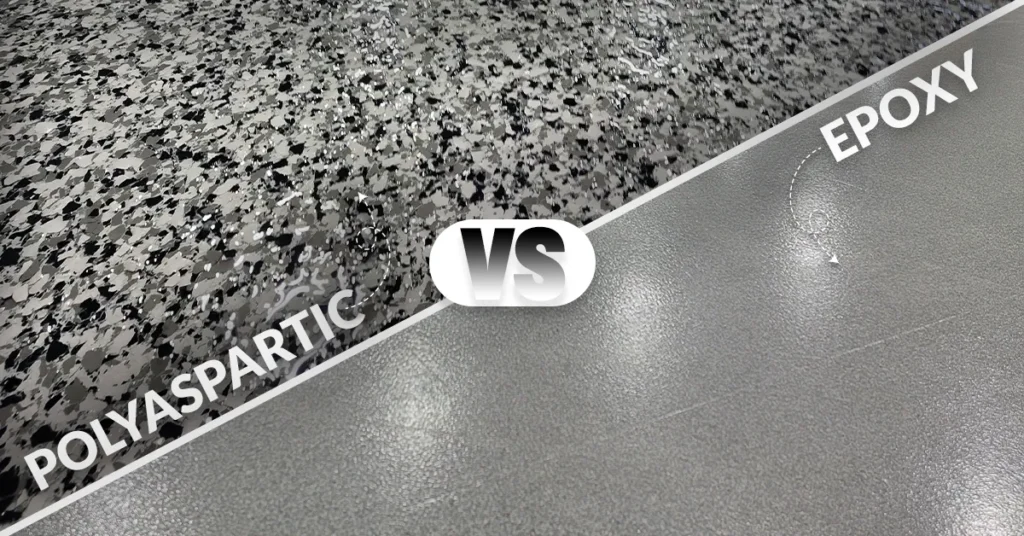Choosing the right floor coating for your garage, basement, or patio can feel overwhelming. If you’re torn between polyaspartic vs epoxy, you’re not alone. Epoxy is the familiar name most people know, but polyaspartic is stepping up as a premium alternative. Both can turn dull, stained concrete into a clean, stylish surface, but which one fits your needs?
Let’s break it down with a detailed comparison.
Polyaspartic vs. Epoxy Flooring: Which One Is Best for Your Project?
Choosing the right epoxy floor coating is a big decision. You don’t just want something that looks good but something that lasts, too. Two of the strongest options today are polyaspartic and epoxy. Both are tough, durable, and protect concrete, but they work differently. This guide will break down the key differences in simple terms so you can make the best choice for your project.
Understanding Floor Coatings: Base Coat vs. Top Coat
Before comparing epoxy and polyaspartic, it’s important to know how floor coatings work. Most systems have two main layers: the base coat and the top coat. The base coat is the first layer that bonds to the concrete. It needs to stick well and provide strength. The top coat is the final protective layer that resists scratches, chemicals, and UV rays. You can use epoxy or polyaspartic for either layer, but each one performs better in certain roles.
When it comes to concrete coatings, choosing the right combination of base coat and top coat is critical to long-term performance, durability, and appearance. Whether you’re coating a garage, a patio, or a commercial space, understanding the differences between epoxy, polyurea, and polyaspartic systems will help you make the most informed decision for your environment and usage.
While all three materials are incredibly strong and commonly used in the industry, each one performs differently depending on factors like sunlight exposure, temperature fluctuation, and surface conditions. Let’s break down how each one works best and where.
The Role of the Base Coat
The base coat is the foundation of any concrete coating system. Its primary function is to adhere to the concrete surface and provide a strong anchor for the rest of the system. Both coating types, epoxy and polyaspartic, can be used as base coats, but they behave very differently once applied.
Epoxy is often considered the best base coat when maximum adhesion is the goal. Because it cures more slowly, it has more time to penetrate into the concrete pores, creating a deep, lasting bond. This makes it an ideal choice for indoor spaces or shaded areas where sunlight is not a concern. However, epoxy has a well-known drawback: it tends to turn yellow and amber quickly when exposed to direct sunlight.
Polyaspartic, on the other hand, is the go-to solution for outdoor or sun-exposed areas. It has the highest UV resistance of the three and holds up the best over time under direct sunlight. However, it cures extremely fast, which limits the time it has to soak into the concrete. That tradeoff means it doesn’t bond quite as strongly as epoxy, but in situations where sunlight protection is the priority, that’s usually a worthy compromise.
The Importance of the Top Coat
While the base coat handles adhesion, the top coat is your protection layer. This is what shields the system from scratches, UV rays, weather damage, and foot or vehicle traffic. In nearly all professional-grade applications, polyaspartic is the preferred top coat.
Polyaspartic finishes are extremely scratch-resistant, resist yellowing from sun exposure, and hold up beautifully even in high-traffic areas. Whether the base is epoxy, polyurea, or polyaspartic itself, applying a polyaspartic top coat creates a clean, durable, and long-lasting finish that protects the integrity of the system.
Matching the Right System to the Environment
Here’s how to think about it: your environment determines your base, and your desired durability determines your top.
In cool, shaded, or indoor areas, epoxy is usually your best base option because of its unmatched bond with the concrete.
And in sun-exposed outdoor environments, polyaspartic is the most UV-stable material and is usually preferred as both the base and the top coat, especially when aesthetics and sunlight durability are priorities.
Drying Time and Bond Strength: Which Sticks Better?
Epoxy is known for its strong bond but slow drying time. It usually takes 12 to 24 hours between coats, which allows it to soak deep into the concrete. This deep penetration creates a strong, long-lasting bond, making epoxy ideal for base coats. Once cured, it forms a thick, durable layer that resists peeling.
Polyaspartic, on the other hand, dries extremely fast—often in just 1 to 2 hours. This makes it great for quick jobs, but it doesn’t penetrate concrete as deeply as epoxy. Instead, it bonds mostly on the surface, which makes it less ideal as a base coat. However, its fast curing time makes it perfect for top coats in high-traffic areas.
When it comes to adhesion, epoxy is the better choice for base coats because it sticks better and lasts longer. Polyaspartic is weaker as a base coat since it dries too fast to form a deep bond.
Sunlight and UV Resistance: Which Won’t Turn Yellow?
If your floor gets sunlight, UV resistance is a significant factor. Some coatings turn yellow or fade over time when exposed to UV rays.
Polyaspartic is highly UV-resistant, meaning it won’t yellow or fade. This makes it perfect for outdoor spaces like pool decks, patios, and driveways. It’s also a great choice for showrooms or retail spaces with bright lighting.
Epoxy, however, does not handle sunlight well. Over time, it will turn yellow when exposed to UV rays, making it a poor choice for outdoor use unless it’s covered by a UV-resistant topcoat. It works best in indoor spaces like garages, basements, and warehouses where sunlight isn’t a concern.
When it comes to UV protection, polyaspartic is the clear winner, while epoxy should be avoided in direct sunlight unless sealed with a polyaspartic top coat.
Cost: Is Polyaspartic Really More Expensive?
Many people assume that polyaspartic is more expensive than epoxy, but that’s not always true. Pricing depends on several factors, including solids content, labor, warranty, and prep work required.
A high-quality epoxy can cost just as much as a polyaspartic while a cheap polyaspartic might be weaker than a premium epoxy. Labor costs can also vary as epoxy takes longer to install due to its slow drying time, whereas polyaspartic can be applied and finished in a single day.
Instead of choosing based on price alone, focus on the quality of the product and its suitability for your project. A slightly more expensive coating may save you money in the long run by lasting longer and requiring fewer repairs.
Which Floor Coating Should You Choose?
When to Use Polyaspartic
Polyaspartic is the best choice when you need fast installation, UV resistance, or a hard, scratch-resistant top coat. It’s ideal for outdoor spaces like pool decks, patios, and driveways, as well as high-traffic indoor areas like showrooms and retail floors.
When to Use Epoxy
Epoxy is the better option for indoor spaces where UV resistance isn’t a concern. It’s perfect for garages, warehouses, basements, and industrial floors where moisture resistance and strong adhesion are important.
What Do Flooring Pros Recommend?
Experienced installers agree that epoxy is the best base coat because it grips concrete like nothing else. They also recommend polyaspartic as the best top coat because it dries fast and resists damage.
Some companies use only polyaspartic for speed, but this can lead to peeling if the base isn’t properly prepped. The smart choice is to use epoxy first for strength and then polyaspartic for long-lasting protection.
FAQs
Can I apply polyaspartic directly over concrete without an epoxy base?
While possible, it’s not recommended. Polyaspartic’s fast cure limits its penetration into concrete, resulting in weaker adhesion. For best results, professionals recommend using an epoxy base coat with a polyaspartic top coat.
How long do these floor coatings typically last?
With proper installation and maintenance, high-quality epoxy floors can last 10-20 years in residential settings, while polyaspartic systems often last 15-30 years. Commercial/industrial applications may see slightly shorter lifespans due to heavier use.
Are these coatings slippery when wet?
Both can be slippery when wet, but anti-slip additives can be incorporated during application. Many installers broadcast decorative flakes or use specialized traction additives for safer walking surfaces.
Can I apply these coatings myself, or should I hire a professional?
While DIY kits are available, professional installation is strongly recommended. Proper surface preparation (often including grinding, repairs, and moisture testing) requires specialized equipment and expertise for optimal results.
How do temperature and humidity affect the installation?
Epoxy is more temperature-sensitive, typically requiring 50-90°F for application. Polyaspartic is more forgiving, with some formulations applicable in temperatures as low as 30°F, making it better for seasonal installations.
Making the Right Choice for Your Flooring Needs
After examining all the factors – from curing times to UV resistance and application requirements – it’s clear that both epoxy and polyaspartic coatings offer distinct advantages depending on your specific situation. For most residential and commercial applications, the ideal solution often combines the strengths of both materials: an epoxy base coat for superior adhesion and moisture protection, topped with a polyaspartic wear layer for UV stability, fast installation, and long-lasting beauty.


